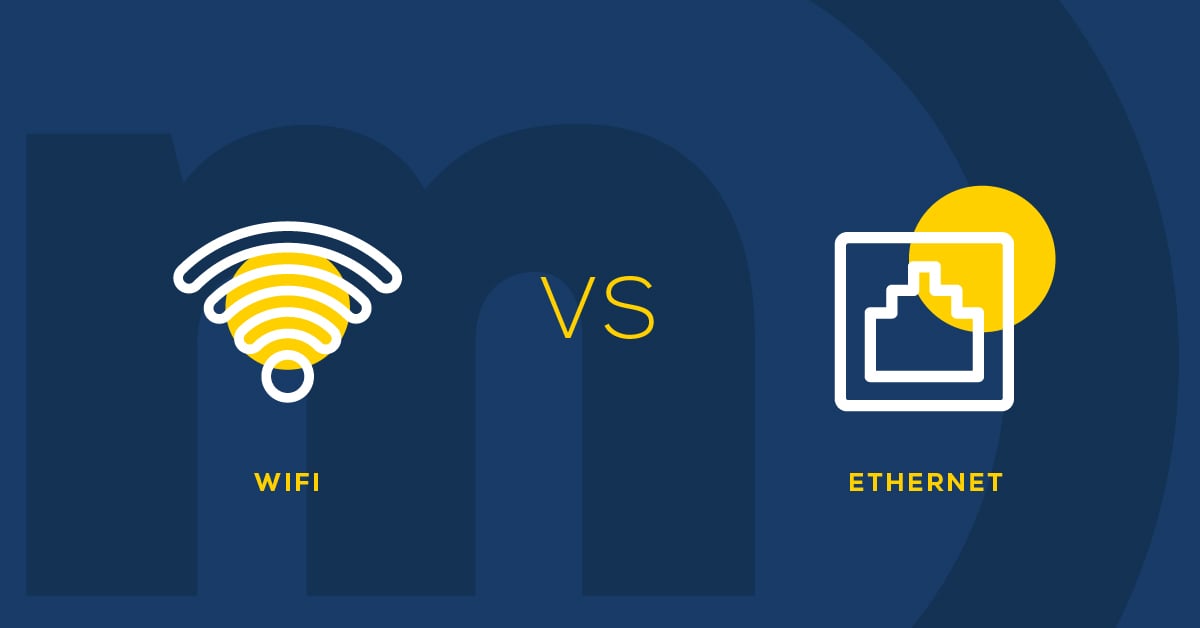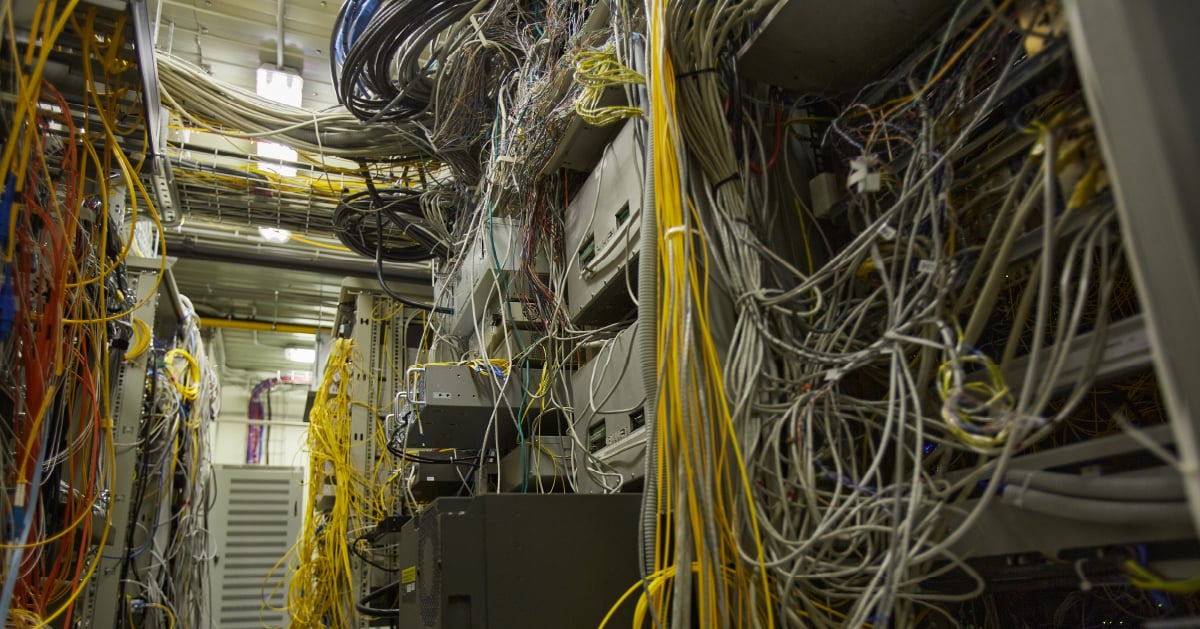When it comes to determining which of these networks for business is better, the conversation has to start with you. Which network do you currently have, and is it meeting your needs? What problems are you facing with it? These are likely the most important questions to begin assessing your current network.
Advantages and Disadvantages of Wired vs. Wireless Networks

Wi-Fi lets devices connect wirelessly so that you can roam freely. You can use access points to boost the signal and increase its range. Wired networks use cables to connect devices to the internet, with the obvious downside that your device will be physically connected to a switch or router. If that were the only consideration, every office would be wireless. But it isn’t. Read on!
Speed
Wireless networks tend to be slower than wired for a few reasons:
- Wired networks have higher raw bandwidth capacity, which allows more data to be transferred at faster speeds
- Walls, objects, and other devices can interrupt wireless signals
- Wireless networks require more processing overhead to handle signal sharing and interference
- Unless you use additional access points to boost the signal, a wireless network’s signal will become weaker the farther your device is from the router
- Increased congestion from many users will slow the speed of a wireless network
- The latest wired standards like CAT6a offer 10Gbps or more, while wireless standards like 802.11ac only recently reached gigabit speeds
The winner: Wired…usually
Reliability
Wired networks are generally more reliable than wireless networks, for the reasons outlined above, plus a few others:
- Wired connections are not subject to interference or variations in signal strength that can cause dropped connections
- Wired networks offer lower and more consistent latency since they don't have to deal with radio interference or congestion in the air
- Wired performance is easier to model and predict based on standardized cable capabilities
- It's simpler and cheaper to build redundancy into wired networks by adding parallel cable runs
You can improve the reliability of your wireless network with additional access points, mesh topologies, and capacity planning. But wired networks still edge them out when rock-solid stability matters most.
The winner: Wired
Security
Since wired networks use physical cables, it's harder for hackers to access them. Therefore, these networks aren't vulnerable to certain attacks like war driving, evil twin access points, or denial of service attacks over the air. However, most wireless intrusions actually exploit wired connections upstream. And today’s modern cybersecurity tools are sufficient to determine the who, what, where, and when of a data breach on both wired and wireless networks.
The winner: Wired is easier, although you can also properly secure a wireless network with additional effort and know-how
Convenience

With a wired network, employees can resent the tangle of wires beneath their desks. It's usually not a functional issue, but troubleshooting can also be a challenge due to the sheer amount of cables. That’s why, in most office environments, employees prefer a wireless connection.
The winner: Wireless
Cost
Wired networks are typically more expensive to install than a wireless network due to additional labor and cable requirements. Since each workstation and device in the office that needs a connection requires a wire running to it, the size of your office space will affect the cost of a wired network.
The winner: Wireless
Flexibility
Nowadays, it’s common for employees to have more than one smart device. For this reason, the flexibility and scalability of wireless networks can be especially appealing. With a wireless network, it is easy to provide employees with access, which they can use to connect multiple devices. Tablets, smartphones, and laptops can all connect to the network, allowing employees to access work files on the go, without a physical connection.
And as people can walk into most public and commercial spaces and get access to Wi-Fi for free, if you frequently have visitors in your office, they’ll probably expect the same.
The winner: Wireless
A Hybrid Solution
You don’t necessarily have to choose between a wired or wireless network. A wireless network that is integrated with your wired network allows your employees to access the network remotely while also providing guests with complimentary internet access on your premises. It also maintains the main benefits of a wired network: better speed, security, and reliability.
Securing Your Network — Wired or Wireless

Contrary to popular opinion, although a wired network is easier to secure, that doesn’t mean it necessarily IS more secure. I touched on this earlier, but there are many additional factors that go into establishing a secure connection, like keeping operating systems up to date, requiring and enforcing a proper password policy, and maintaining the security of every connected device.
Wi-FI networks are typically harder to secure, but some business technology companies — like Cisco — are making it much easier.
An Overview of Cisco’s Identity Services Engine
Cisco’s Identity Services Engine (ISE) is a security policy management and access control platform that can help secure and manage wired and wireless network access. Here’s the short list of what we Marco folks like about it:
- ISE makes it easy to control who and what can access your network
- You’ll get full visibility into all connected devices on your network at any given time
- Segmentation, encryption, and more can be automated across users and devices based on role, location, time, and the like
- ISE can quickly isolate or restrict compromised devices and users
- It provides you with detailed access logs to help demonstrate compliance with security policies and any regulations
- Onboarding and guest access can be streamlined through self-service portals
- ISE integrates seamlessly with Cisco switches, routers, firewalls, and endpoints
Additional Cisco Products To Consider
If you’re experiencing network problems since you’ve moved to the cloud, you’re not alone. Traditional WANs weren’t designed to do what many businesses are now asking them to do, and the result is additional congestion and delays. SD-WANs offer a faster, smoother experience when using online tools. Cisco Catalyst SD-WAN offers built-in automation, multi-cloud capabilities, analytics, predictivity, and security, plus a great deal of flexibility.
Cisco Umbrella is a cloud security platform that protects users on and off the corporate network, which is especially helpful for companies with remote or hybrid workplaces. Here are a few reasons you might want to consider it for your network security:
- Umbrella can be deployed quickly, and it doesn’t require on-premise hardware
- It uses threat intelligence from Cisco Talos to quickly identify and block connections to malicious sites
- Web traffic can be filtered based on content categories, keywords, or reputation
- By enforcing policies at the DNS layer, Umbrella can block threats for any device, either on or off the corporate network
- Umbrella sandboxes and inspects files to identify and block delivery of malware
- A simple dashboard offers visibility into internet usage, security events, and threats across the network
- Umbrella can act as a secure proxy for web traffic to monitor and log all activity
Are These Solutions the Best Fit?

Network performance and security are top concerns for many organizations these days. If they’re also a concern for you, then first of all, I’d like to thank you! The more cybersecurity concerns are brushed aside, the easier it is for hackers to keep doing what they’re doing, and the worse it is for every honest business to keep serving its customers. You’ve likely also realized that when your technology is under-performing, your productivity might be too. Nice!
As a business technology provider, a significant part of our job is researching the very best solutions for our clients that will keep them happy in the long run. That’s what we’ve found in Cisco, which is why we put in the work to become a Cisco Gold Partner. Our clients can access our certified Cisco Internetwork Experts (CCIEs) and also get the very best pricing.
If you’re still in the research phase and want to make sure your technology dollars are spent wisely, we can help with that as well. Our technology assessments aren’t just a quick scan but offer a thorough investigation of your entire infrastructure. Our experts can also tailor your assessment to focus on disaster planning, an insurance event, a change in business leadership, or, in this case, the optimization and security of your network.
Click below to learn more about our assessments and how we work!
Learn More About a Technology Assessment
